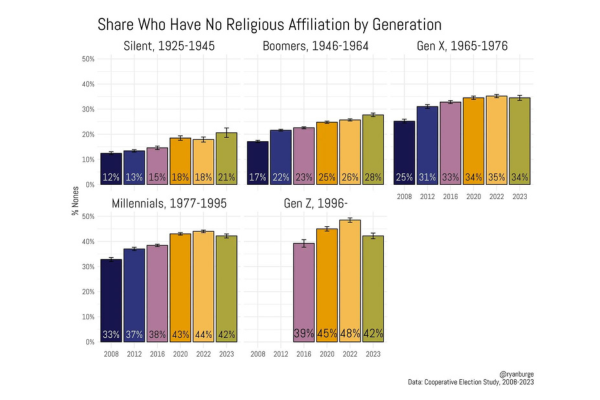
Six Important Things to Understand Right Now About Generational Nones
A few months ago I was unpacking a demographic report with a cohort I was leading. There was a mixture of initial reactions from the group. Some of the participants’ eyes glazed over. Some were overwhelmed. Others were frustrated and vocalized their confusion as to why this dense information mattered.
While I may admittedly like demographic information and statistics more than many, it is important for church leaders to have at least a basic understanding of their mission field. Since reaching new people is the mission of the church, it is helpful to first know and understand who it is that we are trying to reach. Otherwise, what evangelism and ministry opportunities we are offering may miss the mark for the very people the church is trying to reach. Therefore, it is extremely critical for church leaders to have their finger on the pulse of current demographic and statistical information so that their ministries are relevant and contextual.
In light of being informed church leaders, here are some new generational statistics that I feel the church should be paying attention to from the Cooperative Election Study. We often contribute church decline to the youngest generations. However, the latest data indicates the largest rise in those who have no religious affiliation is the Boomer Generation (born between 1946 and 1964). From 2008 to 2023, there was an 11% increase in Boomers reporting no religious affiliation (17% to 28%). The Silent Generation (born 1925-1945), Gen X (born 1965-1976), and Millennials (born 1977-1995) all had a net 9% increase during the same period.

Another interesting trend is the increase in the number reporting no religious affiliation between 2008 and 2012. Gen X saw the largest increase (6%), followed by the Boomers (5%), then the Millennials (4%), and finally the Silent Generation with the lowest increase (1%).
In looking at the overall share of each generation who report having no religious affiliation, the Millennials and Gen Z come in highest at 42% in 2023. In contrast, the Silents had 21%, the Boomers had 28%, and Gen X had 34% of their generations reporting no religious affiliation. As an overall US population, approximately 30% have no religious affiliation. About 7% are atheist and another 7% are agnostic.
While the Silent and Boomers continuously trend upward, the other three Generations actually saw a slight tick downward in 2023. Gen X and Millennials saw a 1% decrease in those reporting no religious affiliation from 2022 to 2023. Surprisingly, Gen Z experienced a whopping 6% decline from 2022 to 2023 in those reporting no religious affiliation.
Here are six important things to understand right now from this generational report on those with no religious affiliation:
ALL generations have become less religiously affiliated – not only the youngest generations.
With the Silent Generation becoming less active and the Boomers having less religious affiliation, traditional offering plate generosity is shifting. Other revenue sources will often need to be considered.
With the higher share of no religious affiliation in the younger generations, the overall average age of church congregations has risen. In my experience, this is especially true of churches who have not been intentional in making innovative ministry shifts to reach younger generations.
The data clearly indicates that the way the church has been operating to reach new people has not been working for quite some time. We must be willing to rethink what it means to be the church and how to fulfill its mission of sharing Jesus with more people.
The nones (as opposed to the “dones”) are the most open group to reach. This is such an evangelistic opportunity for churches if we would be willing to rethink church.
The nones are dropping out of the Protestant faith more than Catholic or other world religions. There seems to be a clear line between a lack of relevance for the nones in the Protestant faith.
How will you use this data? What surprised you about this data? What might your church leaders take away from this data? How might these trends reflect on leading your church in a new direction in the next few years? What might your church leaders want to consider shifting after studying this information?
If your leaders are looking for resources to assist them in thinking about reaching your mission field in new ways, consider these resources:
On-Demand Webinar: Inside Out: Everting Ministry Models for the Postmodern Culture
Book: Inside Out: Everting Ministry Models for the Postmodern Culture
Book: Innovating for Love: Joining God’s Expedition through Christian Social Innovation
On-Demand Webinar: Who is Your Neighbor?


